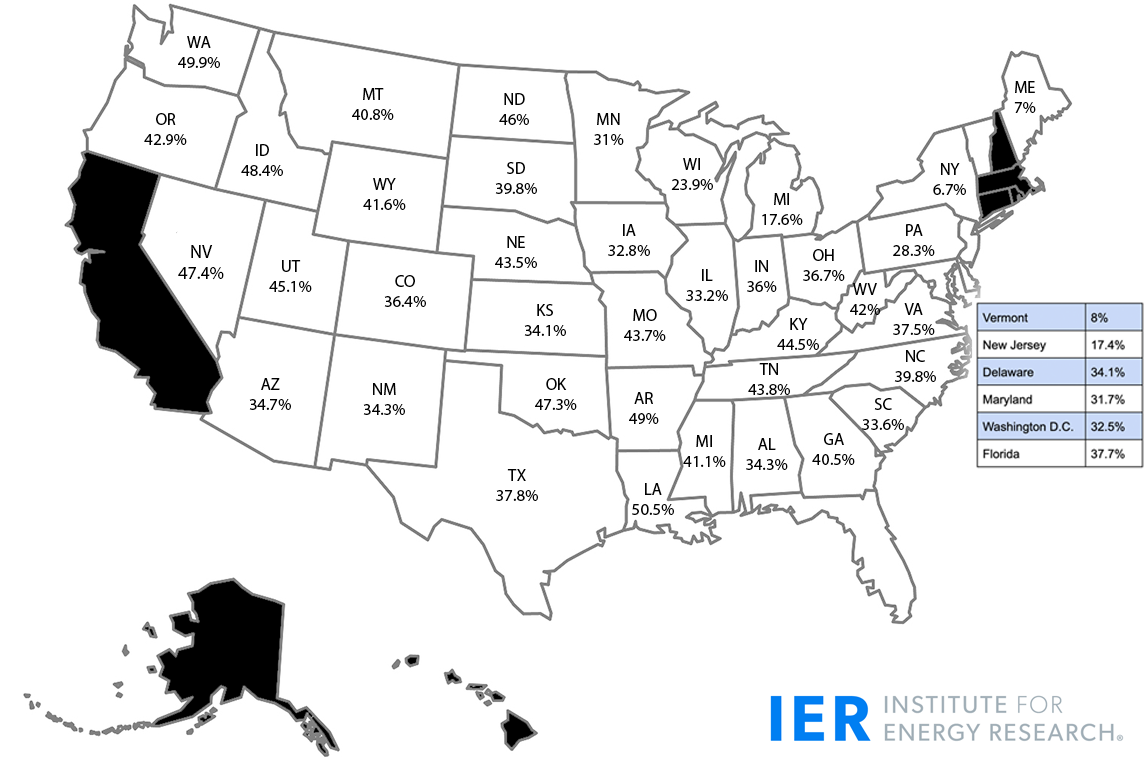California set its first renewable portfolio standard in 2002 and currently requires 60 percent of its generation to come from renewable energy by 2030 with the next 40 percent of generation to come from zero-carbon sources by 2045. These non-carbon sources will likely be wind, solar, geothermal, and hydropower. California is shuttering its last nuclear plant in the next few years and new nuclear cannot compete economically with these other non-carbon sources.
During a recent heat wave, California was forced to implement rolling blackouts because it had insufficient power to meet demand when its solar generation declined in the evening, Normally, it purchases power from neighboring states when this occurs, but those states did not have extra power to sell due to the heat wave. California got caught because it had retired many natural gas and nuclear plants, and did not have sufficient back-up power to fill in when its intermittent renewables could not find enough sun or wind to continue operating.
Democratic Party presidential nominee Joe Biden, if elected, will be forcing the rest of the country into a similar plight with his “clean energy standard,” which requires 100 percent electricity to be generated from non-carbon sources by 2035. Whether it is even feasible on a national scale is doubtful, but it will undoubtedly be expensive to electricity consumers and to taxpayers.
Electricity Prices
While electricity production from fossil vs. renewable sources varies by state, the energy decisions that each state makes ultimately affect the price of generation and costs to consumers. For instance, Massachusetts had the third highest residential electricity price in the nation in 2019 mainly due to the lack of natural gas pipeline infrastructure, but also due to the premature retirement of fossil fuel generating capacity. California had the seventh highest residential electricity price in the nation in 2019 because of their zeal for carbon free and non-nuclear generating capacity. In 2019, 30 percent of California’s utility-scale electricity came from non-hydroelectric renewable energy, including 5.6 percent that came from industrial geothermal production, in which California leads the nation with 70 percent of U.S. geothermal production. Including hydroelectricity, 49 percent of the state’s utility-scale power was generated by renewable energy in 2019. (See graph below.)

Besides utility-scale generation, one million Californians have put solar panels on their homes—a requirement for newly built residences, despite the added cost. Some homes are installing battery systems, like Tesla’s, which cost about $10,000.
Other States Compared to California
California is not the only state pursuing an all carbon-free and mainly renewable electricity future. In New York, Governor Cuomo has called for the expansion of the state’s “clean energy standard” so that 70 percent of New York’s electricity comes from renewable energy sources such as solar and wind by 2030, followed by 100 percent carbon-free electricity by 2040 and an 85 percent reduction in greenhouse gas emissions by 2050 under the Climate Leadership and Community Protection Act. New York is shuttering the Indian Point nuclear plant that supplies power to New York City—one unit was closed in April and the second unit will be shuttered next April. By shutting down just one of Indian Point’s two reactors this year, New York lost more carbon-free electricity than produced annually by every wind turbine and solar panel in the state. New York still needs to figure out how to replace their output.
One project currently under negotiation in New York is the Champlain Hudson Power Express transmission line, which is expected to deliver 24,000 megawatt hours of hydropower daily through a transmission line that runs from Québec, Canada to New York City. However, environmentalists are calling for the city to scrap the project because of concerns about the environmental impacts of the transmission line that include the potential creation of new dams in Québec and the impact of the transmission line cable that will be buried into the Hudson River’s riverbed.
New York has the eighth highest average residential electricity price in the nation and shuttering Indian Point will only raise it. But, thankfully for consumers, not all states are following California’s and New York’s lead. The following map depicts the 43 states that have lower residential electricity prices than California and provides how much lower their residential electricity price is relative to that of California’s price. For example, New York’s average residential electricity price in 2019 was 6.7 percent lower than California’s in 2019. California’s average residential electricity price was 32 percent higher than the nation’s average residential electricity price in 2019.
Residential Electricity Prices Relative To California

Note: The states depicted in black are California and the 6 states that had higher electricity prices in 2019 than California.
Not all states are endowed with renewable resources, such as the southeast where wind resources are poor. As a result, one size does not fit all and using California’s electricity system as a pattern for the nation, as Joe Biden is doing, is not beneficial to Americans for it will only increase electricity prices in the 43 states that have lower prices than California.
Conclusion
Americans need to see where Joe Biden and his party platform are taking the nation with their Green New Deal Clean Energy Standard. Americans complain if legislators torque their gasoline prices, but they should also keep an eye on policies that will increase their electricity prices and threaten the competitiveness of their businesses because these will not only affect their pocketbooks as consumers, but also as taxpayers since Biden indicates he needs $2 trillion—to start! If energy is made too expensive in the United States for businesses to produce things domestically, they will move to places that do not have such policies, taking jobs and opportunities with them. With American companies finally moving jobs back to our own shores, now is not the time to artificially increase the cost of energy in the United States.



